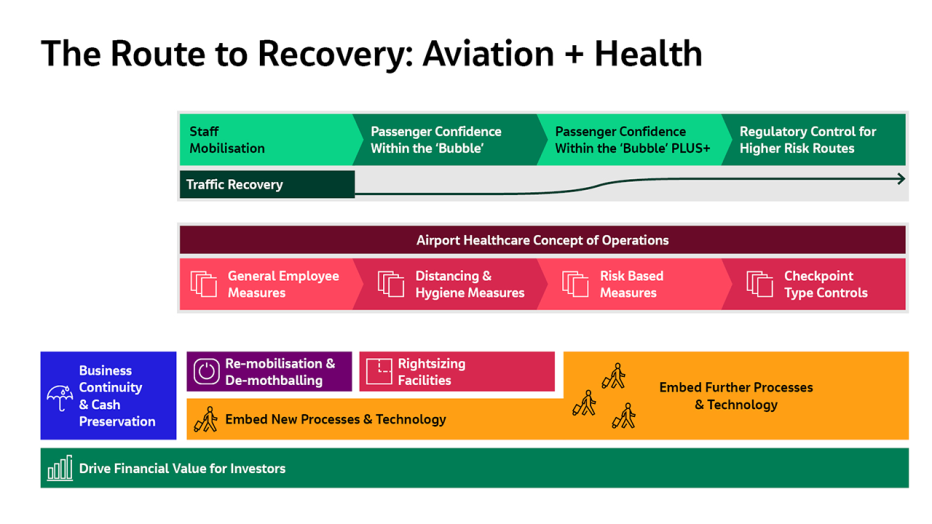
While the world continues through the COVID-19 pandemic, the global aviation industry is experiencing unprecedented challenges as a result of the virus spread and its resultant impact on air travel.
The first step in the return of significant levels of traffic to the world’s airports will be ensuring the safety of both employees and passengers. Focus must be on restoring the confidence of the traveling public and the ability to create a safe environment for themselves and the staff who facilitate their travel. As workers are remobilized and passenger confidence grows simultaneously, so will the rate of demand for air travel.
The public’s confidence to return to airports and public transportation, in general, will likely be on the same trajectory as their confidence to return to any sizable gathering and/or event such as a shopping mall, sporting event or campus.
Consistent regulation will support confidence but is especially important for international flights (and international travel of all modes) when compared to domestic travel. Collaboration by airports, airlines, government and industry groups will help allow for the same level of regulation and control of public health measures in the context of travel as we see today in safety, security, customs and immigration.
Demand will most likely first return with domestic flights where passengers and airlines are travelling within a single, commonly understood set of regulations and social norms. As society continues to understand COVID-19 and related risk factors better, travel demand will extend to a growing set of countries that have achieved a similar level of control of the pandemic. The final hurdle will be travel either from COVID-19 hotspot locations or to sensitive isolated destinations with low prevalence.
As we work collectively as an industry to address these issues, Jacobs has produced a stepped recovery plan for airports and aviation to help clients on the journey towards a pre-pandemic level of demand. As we assist clients in developing scenarios for traffic recovery, we recognize the fact we are in uncharted territory and it is difficult to predict how airlines, and business and leisure markets will react over the long-term. Where possible we have sought to identify measures that might help mitigate the impacts, many of which we are already seeing being put into place by airports around the world.
Business Continuity - Survival Instincts

What can airports do when 95% of traffic, and therefore revenue, is down? Many take steps to ensure business continuity and survival instincts kick in. Since there is no true precedent for the circumstances airports are currently facing, it is nearly impossible to predict when demand will return. Second to that is the difficulty in understanding what air services will look like once it does return – will airlines fly to the same cities and maintain the same routes? Will see smaller planes to make it more economic to fly with less than a full passenger load? While uncertainty currently rules the day, we’re helping clients around the globe on their journeys of closing some or all of their facilities and, in doing so, assisting with the careful planning of infrastructure remobilization for Day Zero. It’s about making sure that everything that has been paused is able to be safely restarted at the right time.
As a small silver lining for airports who are in a position to seize the opportunity of using available funding to expedite projects from gate refurbishments to runway resurfacing is the opportunity to save time and money. Instead of completing construction activity on a nightly schedule, returning the asset to service within a handful of hours – some airports are extending closures for weeks or months to complete targeted repairs, deferred maintenance projects or long-duration tasks. This is particularly noticeable in the U.S. where airports are generally federally funded and less so amongst the privately-owned airports elsewhere in the world where funds have dried up along with the passengers.
De-Mothballing and Remobilizing for Day Zero

Though it may not feel like it, Day Zero is coming, the first step of airports serving a significant portion and eventually all of their pre-pandemic passenger levels. Airports are at different places on the journey towards reopening and economic recovery. In Asia, airports are starting to see a return of traffic in domestic markets at least. While in Europe and the U.S., traffic has still to show significant signs of recovery and airlines are still temporarily relocated into different terminals and airports are operating reduced runways to reduce costs.
Reopening will take the coordination of everything from airfield inspections and testing of terminal facilities (security, baggage, ticketing) to airport access by public transportation and the preparedness of all other stakeholders in the aviation travel experience. Many of the practices more commonly applied to the Operational Readiness & Transition (ORAT) when opening new terminals and airports, will now effectively be required for the re-opening of complex airport infrastructure.
Right-Sizing – Push the Reset Button?

Prior to the pandemic, many airports were facing record-breaking growth, with a pressure to expand capacity and increase facilities. But in the new normal, will it be business as usual or a balance between the efficient use of facilities with reduced traffic levels and the need to provide sufficient additional space to enable passengers to safely and confidently travel through airports?
Airports who currently have expansion projects in progress are also asking “how do we plan for the next global public health event and how does this influence current designs?” Similarly, there are a number of greenfield airports in construction around the world who are re-examining their master plans and terminal designs to consider how health care measures might be fundamental to their plans rather than an add on.
In a variety of locations, we are helping airport clients with passenger modeling to test the impact of potential operating scenarios, considering different ends of the spectrum from physical distancing and queuing space to the impact on facility requirements of additional health check processes.
New Technology - Terminal Planning in a Brave New World

The brave new world will require a lot of planning. From the application of good hygiene practices and physical distancing to implementing as many contactless operations as possible, now is the time to design smarter. Because an airport is like any public space the same concerns and solutions being contemplated by society will apply to airports and vice versa.
The new normal will also see new partnerships between different industries. Take for example the nexus of health and transportation. Our future will pair the knowledge of public health practitioners and designers and engineers from aviation and health industries to accommodate health screening, monitoring and infection control measures for departing and arriving passengers. The combination of these areas of expertise within Jacobs is already helping airports look at various scenario planning efforts to inform discussions with regulators and to plan for Day Zero reopening.
Driving Value

Whether privately or publicly owned all airports are still like any other business and need to protect the interests of their owners and investors be they the local municipality or a global airport operator. During this period of drastically reduced traffic all airports without exception will be managing their revenues and expenditure like never before.
Airport operations will be optimized to achieve maximum efficiency, capital expenditure plans will be ruthlessly prioritized to address only the immediate business imperatives and airports will be using all their ingenuity to identify new ways of generating new income streams.
We are busy helping airports understand their true costs, identify areas for efficiency and implement rigorous capital planning and prioritization processes.
As we look towards the return of air traffic, in addition to the usual challenges of airport operation, finance and development we see a new and essential collaboration between aviation and health to protect passengers and staff from bio threats and re-establish the industry. At Jacobs, we’re combining health systems and public health experts, with aviation professionals who fully understand the development and operational requirements of airport and airline systems across the world. Our collective expertise will support our clients in the period of change from aviation today to the “new normal” whatever that may be.














































